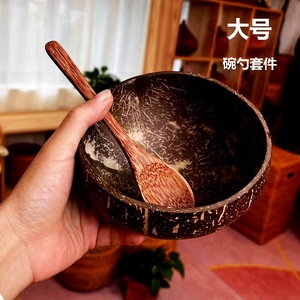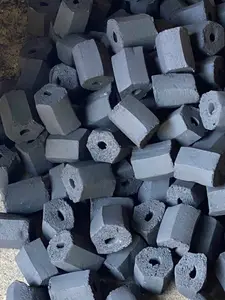(238 products available)



































































































































































































Coconut shells are the hard, woody outer coverings of coconuts, which serve several purposes due to their durability and unique structure. Here are some common types of coconut shells based on their treatment and use:
Natural Coconut Shells
These are untreated shells used mainly for their structural properties. Natural coconut shell types still have residual nutrients beneficial for soil and plant growth.
Dry Coconut Shells
Drying coconut shells removes moisture, making them harder and more brittle. Dry coconut shell types are often ground into mesh or powder for use in gardens, crafts, and filtration systems.
Activated Coconut Shells
Activated coconut shells are heated under pressure to create pores. This increases their absorbent qualities, making them suitable for medical and environmental applications. Coconut shell charcoal is a common form of activated coconut shells used in filtration and detox products.
Ground Coconut Shells
Processed into fine or coarse particles, ground coconut shells are used as a soil amendment in horticulture, as an abrasive in manufacturing, and even in cosmetics. Buyers can get coconut shell grain in fine or coarse grains for different uses. Fine grains may be used for cosmetic exfoliants or in paints, while coarse grains are useful for soil amendments or industrial abrasives.
Coconut Shell Chips
Coconut shell chips are small, untreated pieces of coconut shells, typically used as a decorative mulch in gardening, for terrarium substrates, or in aquariums. They provide an aesthetic natural look and improve plant growth by insulating the soil and reducing moisture evaporation.
Coconut Shell Powder
Coconut shell powder is a fine material used in making plastics, as an abrasive in products like soap, and in the production of activated carbon. In cosmetics, it may be used for exfoliation or oil control in skin care products.
According to the recent reports, coconut shell uses vary widely across industries due to their durability, density, and eco-friendly properties.
Animal Bedding
In agriculture, coconut shell mulch is used as bedding for animals such as chickens and horses. It absorbs moisture well and keeps the animals dry and comfortable.
Coconut Shell Charcoal
One of the most common uses is making coconut shell charcoal. The charcoal is used for cooking, metallurgy, and as a fuel source in areas where coconuts are abundant. It is efficient, producing less smoke and ash than regular wood charcoal.
Plantation Ownership
Coconut trees are grown in large plantations for commercial purposes. The shells, water, and oil are all extracted and sold globally, especially to countries like India, the Philippines, and Sri Lanka, where coconuts are abundant.
Organic Fertilizers
Crushed coconut shells mixed with other organic materials create an nutrient-rich organic fertilizer. This enhances soil health, promoting sustainable agriculture practices.
Coconut Shell Substrate
Coconut shell chips and fibers provide a natural substrate for orchids and other epiphytic plants in horticulture. It retains moisture while allowing proper drainage for healthy root growth.
Biocomposite Materials
Ground coconut shells are mixed with resins to create biocomposite materials. These materials are lightweight, strong, and environmentally friendly, making them popular in the automotive and construction industries.
Coconut Shell Oil Absorbers
Activated coconut shells are used to absorb excess oils and pollutants from industrial wastewater. This helps reduce environmental impact and is particularly useful in coastal areas prone to oil spills.
Coconut Shell Powder
Finely ground coconut shells are used in making phenolic resins, plastics, and other industrial materials. These powders serve as abrasives in cosmetics, pet care products, and even in agricultural pesticides for controlled release.
Coconut shells offer a wide range of practical applications across various fields, from environmental sustainability to everyday uses in crafts and gardening. Here are the ways to use them:
Coconut Shell Cups and Bowls
Coconut shells can be carved into cups, bowls, and other tableware. These are eco-friendly alternatives to plastic, perfect for serving food or drinks in a rustic style. Buyers can use coconut cup liners as a material for making cups because of the liners durable structure.
Coconut Shell Jewelry
Coconut shells can be sanded, polished, and carved into beads, pendants, and other jewelry pieces. This gives rise to unique necklaces, earrings, and bracelets that are lightweight and sustainable.
Decorative Items
Carved or uncarved shells can be used to create decorative items like lamps, candle holders, or wall art. These bring a natural, tropical feel to home decor.
Natural Mulch in Gardening
Broken coconut shells can be used as mulch in gardens. They help retain moisture in the soil, suppress weeds, and provide a slow release of nutrients to plants.
Animal Bedding
Ground coconut shells are used as an absorbent bedding material for pets like hamsters, reptiles, and birds. It keeps them dry and comfortable.
Eco-Friendly Charcoal
Coconut shells can be carbonized to produce charcoal, which burns cleaner than regular charcoal and is used for grilling or as a heat source in cookstoves.
Coconut Coir Pesticides
Coconut coir, made from fibrous material between the shell and the outer husk, can be paired with coconut shell pesticides to protect crops. The coir helps the pesticide settle at the root level, providing protection from pests and improving soil quality.
Activated Carbon Production
Coconut shells are heated in the absence of oxygen to create activated carbon. This carbon is used in water and air purification systems to absorb impurities and pollutants.
Animal Feed Supplement
Crushed coconut shells can be added to animal feed as a source of fiber and minerals, promoting better digestive health in livestock.
With a few simple tools and materials, coconut shells can be upcycled into useful, beautiful crafts or functional garden products at home. Here’s a step-by-step guide on how to do it:
Removing the Flesh
If there is any remaining flesh inside the shell, carefully remove it with a knife or spoon. Use a small, pointed knife to carefully remove any remaining flesh or thin membrane inside the shell. Be gentle to avoid cracking the shell.
Cleaning and Soaking
After removing the flesh, clean the shell thoroughly with water. For added disinfection, soak the shell in a mixture of water and vinegar (1 part vinegar to 3 parts water) for about 30 minutes. This helps remove any bacteria or remaining residues.
Drying
Let the shells air dry completely in a cool, dry place. Do not expose them to direct sunlight for long periods to avoid cracking. Alternatively, place the shells in an oven at low temperature (around 150°F or 65°C) for 30 minutes to an hour until dry.
Prepping the Shells
Once dry, sand the edges and surfaces of the shell with fine-grit sandpaper to remove sharp splinters and smooth the surface for use or decoration.
Cutting and Carving
Use a small saw or rotary tool like a Dremel to carefully cut the shell into desired shapes (cups, bowls, pendants, etc.). If carving, use small chisels or a rotary tool to gently carve designs into the shell. Work slowly and wear safety goggles to protect eyes from shell debris.
Sanding and Smoothing
Sand the carved or cut pieces with progressively finer sandpaper to achieve a smooth finish. Start with coarse-grit paper and gradually move to fine-grit paper for a polished surface.
Sealing the Shells (Optional)
If using shells for functional items (like bowls or cups), apply a food-safe sealant (like beeswax, carnauba wax, or polyurethane). This helps protect the shell from moisture and makes it more durable. For decorative items, a wood or craft sealant can be applied to preserve the design.
Checking for Mold or Mildew
Coconut shells that have not been properly dried or stored can develop mold or mildew, which may be hard to remove in some cases. Inspect shells for any signs of mold or mildew before buying them. If mold is present, try gently scrubbing with a mixture of vinegar and water, then thoroughly drying the shell in sunlight.
Inspecting Shell Condition
Examine coconut shells carefully for cracks, weakened areas, or excessive holes from previous sprouting. If there are excessive holes or too much internal soft tissue, it will break easily when being carved or used. Avoid shells with large cracks or significant structural damage, as these may not be useful or safe. It won’t be safe to use shells that are having sharp edges because those can cause harm.
Using Appropriate Tools
Always use special tools for working with coconut shells, like a fine saw, a carving knife, and sandpaper meant for carving wood. Using the right tools reduces the risk of the shell splintering and offers a neater cut.
Safety Precautions
Always wear protective gear when cutting or sanding coconut shells. Safety glasses protect the eyes from dust and debris, and a mask prevents inhaling fine particles. Always handle a coconut coconut shell planter with care to avoid sharp edges or splinters. People should wash hands thoroughly after handling shells to avoid skin irritation.
Sealing Properly for Food Use
If making bowls, cups, or other food-related items, ensure to use a food-safe sealant to avoid contamination. These sealants create a barrier between the shell and food, preventing absorption of bacteria or harmful substances.
A1: Coconut shells are recycling into various useful products. These reduce waste and prevent the excessive cutting down of trees for new raw materials. Coconut shells are also used to create activated carbon, which purifies air and water by absorbing toxins and pollutants. Coconut shell products are often biodegradable, breaking down naturally without polluting the environment with plastic or synthetic materials. This helps improve soil quality and supports plant growth.
A2: When coconut shells are burnt, they produce coconut shell ash, which is a rich source of minerals like potassium, calcium, and magnesium. Farmers apply coconut shell ash to fields to nourish crops and improve soil health. The fine texture of the ash can also help control pests and mix easily into the soil.
A3: The longevity of coconut shell products depends on factors like use, climate, and care. Well-treated products like bowls or jewelry can last many years with proper care. Less durable items may last several months to a year. Protective sealing, avoiding excess moisture or sunlight, and regular cleaning can extend their life, especially when used in or exposed to varying environmental conditions.
A4: Burning coconut shells without proper control can release air pollutants, particularly if they are not clean or contain residues. Incomplete combustion may produce smoke or harmful particles. Ash left after burning can contribute to air pollution if not disposed of properly. A coconut shell produces carbon dioxide like any organic matter, contributing to global warming if not balanced by carbon sequestration in plants.